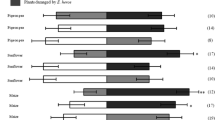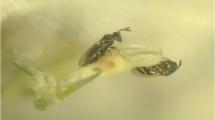Abstract
Reactions of lesser peachtree borer [Synanthedon pictipes (G&R)] to volatiles of peach wood, either natural or chemically fractionated, were observed. Mated females were stimulated by and responsive to such materials and deposited significantly more eggs on substrates, including unnatural hosts, that had been treated with aqueous mixtures of bark-canker materials. Stimulation to oviposit occurred even when the female was blinded, indicating the presence of chemical cues. Natural canker-bark extracts immediately stimulated ovipostion and for a few hours significantly increased the number of eggs laid. However, average fecundity was not increased. Antennectomy did not significantly decrease response to volatiles by gravid females, and alternate sites of such chemoreception were not located. Complex mixtures derived by solvent extraction, steam distillation, and volatiles trapping from bark, canker, and gum all had activity. Observations of insect behavior in outdoor cages and also in the laboratory indicated that visual, chemosensory, and mechanosensory receptors are involved in host finding and oviposition.
Similar content being viewed by others
References
Andersen, J.F., Mikolajczak, K.L., andReed, D.K., 1987. Analysis of peach bark volatiles and their electroantennogram activity with lesser peachtree borer,Synanthedon pictipes (Grote and Robinson).J. Chem. Ecol. 13:2103–2114.
Bobb, M.L. 1959. The biology of the lesser peachtree borer in Virginia.J. Econ. Entomol. 53:634–636.
Brown, W.L., Jr., Eisner, T., andWhittaker, R.H. 1970. Allomones and kairomones: Transpacific chemical messengers.BioScience 20:21–22.
Cleveland, M.L., Wong, T.T.Y., andLamansky, K.W. 1968. Rearing methods and biology of the lesser peachtree borer,Synanthedon pictipes, in the laboratory.Ann. Entomol. Soc. Am. 61:809–814.
Deseo, K.V. 1976. The oviposition of the Indian meal moth (Plodia interpunctella HBN., Lep., Phyticidae) influenced by olfactory stimuli and antennectomy.Symp. Biol. Hung. 16:61–65.
Duncan, D.B. 1955. Multiple range and multiple F tests.Biometrics 11:1–41.
Gentry, C.R., andWells, J.M., 1982. Evidence of an ovipositional stimulant for peachtree borer.J. Chem. Ecol. 8:1125–1132.
Girault, A.A. 1907. The lesser peachtree borer.U.S.D.A. Bur. Entomol. Bull. 68(partIV):31–48.
Hildebrand, E. M. 1947. Perennial peach canker and the canker complex in New York, with methods of control.Cornell Univ. Agric. Stn. Mem. 276:1–61.
King, J.L. 1917. The lesser peachtree borer.Ohio Agric. Exp. Bull. 307:399–448.
Likens, S.T., andNickerson, G.B. 1964. Detection of certain hop constituents in brewing products.Proc. Am. Soc. Brew. Chem. 5–13.
Saxena, K.N., andGoyal, S. 1978. Host-plant relations of the citrus butterflyPapilio demoleus L.: Orientation and ovipositional responses.Entomol. Exp. Appl. 24:1–10.
Stadler, E. 1976. Sensory aspects of insect plant interactions, pp. 228–248,in Proceedings of XV International Congress of Entomologists, August 19–27, Washington, D.C.
Stadler, E. 1980. Chemoreception on arthropods: Sensory physiology and ecological chemistry, pp. 223–241,in R. Gilles (ed.). Animal and Environmental Fitness. Pergamon Press, New York.
Stadler, E. 1983. Attractants, arrestants, feeding and ovipositional stimulants in insect-plant relationships: Application for pest control, pp. 243–258,in D.L. Whitehead and W.S. Bowers (eds.). Natural Products for Innovative Pest Management. Pergamon Press, New York.
Swift, F.C. 1986.Cytospora canker and the establishment of lesser peachtree borer (Lepidoptera: Sessiidae) in peach trees.J. Econ. Entomol. 79:537–540.
Weiner, L.F., andNorris, D.M. 1982. Light and other stimullii in the location of feeding sites by lesser peachtree borer larvae.Environ. Entomol. 11:399–402.
Yamamoto, R.T., andFraenkel, G.S. 1960. The specificity of the tobacco hornworm,Protoparce sexta, to solanaceous plants.Ann. Entomol. Soc. Am. 53:503–507.
Author information
Authors and Affiliations
Additional information
Mention of firm or product names does not imply recommendation or endorsement by USDA over others not mentioned.
Rights and permissions
About this article
Cite this article
Reed, D.K., Mikolajczak, K.L. & Krause, C.R. Ovipositional behavior of lesser peachtree borer in presence of host-plant volatiles. J Chem Ecol 14, 237–252 (1988). https://doi.org/10.1007/BF01022544
Received:
Accepted:
Issue Date:
DOI: https://doi.org/10.1007/BF01022544




